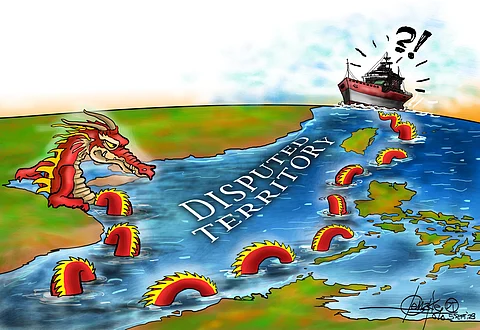
- NEWS
- the EDIT
- COMMENTARY
- BUSINESS
- LIFE
- SHOW
- ACTION
- GLOBAL GOALS
- SNAPS
- DYARYO TIRADA
- MORE

China last week released a new map that expanded its original 9-dash line territorial claim in the South China Sea with the addition of a 10th dash east of Taiwan. That move by Beijing drew strong condemnation from the Philippines, Malaysia and India, and a statement of concern from the United States.
Other nations, especially those with overlapping claims in the South China Sea, can be expected to also vigorously oppose Beijing's new map which was built on the original claim it first floated in the 1940s.
While the Philippines resoundingly won its case against China before the Permanent Court of Arbitration in The Hague with a final ruling in 2016, Beijing has refused to be bound by it and now mocks the same with a 10-dash line map.
Just to recap, the arbitral court recognized the Philippines' maritime entitlement in the West Philippine Sea, which overlaps with the South China Sea. At the same time, it declared China's sovereign claim over nearly the entire SCS legally and historically baseless.
The addition of the 10th dash east of Taiwan is troubling because it may be used by Beijing to lay claim to the Pratas Islands, which are claimed not only by Taiwan but also by Vietnam. Located in the northern part of the South China Sea, the Pratas Islands are strategically important because from there one may control access to the Taiwan Strait.
Geopolitical experts are warning that China's new map may be preparatory to Beijing building military bases in the Pratas as it has done in the Mischief, Gaven, Hughes and Cuarteron reefs, just to name a few. Beijing's control of passage in and out of the Taiwan Strait is simply inconceivable and unacceptable.
Without a doubt, the Taiwan Strait is a vital commercial waterway that connects the Pacific Ocean and the South China Sea, one of the busiest shipping lanes in the world, with an estimated half a million ships passing through it each year. The strait is critical for trade between China, Japan, South Korea, and the US. It is also a major oil and gas shipping route from the Middle East to East Asia.
The numbers should give us an idea why China's 10th dash is being pilloried by nations as inconsistent with international law that guarantees the freedom of navigation. An estimate had put the value of goods transported through the Taiwan Strait at $1.5 trillion in 2022, making it the world's third busiest strait, after the Strait of Hormuz and the Malacca Strait.
China, of course, claims Taiwan as its territory and, in fact, its President, Xi Jinping, has vowed to retake it by force if it comes to that. China has claimed the strait as its internal waters, but the US does not recognize that claim.
One possibility looms large on the horizon: That China will use the 10-dash line claim to justify its continued militarization of the South China Sea, leading to heightened tension between it and the rest of the world that fears unwarranted control by Beijing of the Taiwan Strait.
It has to be emphasized that both the 9-dash line and 10-dash line claims of China have not been recognized by international law. The United Nations Convention on the Law of the Sea, or UNCLOS, which is the main international treaty governing the use of the oceans, does not recognize any country's right to claim territorial waters beyond its 200-nautical-mile exclusive economic zone.
As China has yet to formally adopt the 10-dash line, however, there's a need to review how the arbitral court had ruled in favor of the Philippines in 2016 based on three main findings:
First, China has not historically exercised exclusive control over the waters within the nine-dash line; second, the line cannot be considered a valid maritime boundary; and third, China's actions in the South China Sea, including its land reclamation activities, have violated the Philippines' sovereign rights and its exclusive economic zone.
While Beijing may choose to ignore the arbitral ruling, it is nonetheless a strong legal opinion on the matter that could embolden other countries to challenge China's overreach into their respective territories.
China's actions in the South China Sea are a reminder of its growing assertiveness in the region.
Beijing has been steadily militarizing its claims in the South China Sea, and it has also been using its economic power to pressure other countries into accepting its claims.
The world must stand firm against China's aggression and make it clear that nations will not tolerate Beijing's attempts to bully its neighbors or violate international law.
The stakes are high in the South China Sea. The region is home to some of the world's most important shipping lanes, and it is also rich in natural resources. China cannot be allowed to have its way and put the region in a stranglehold.
